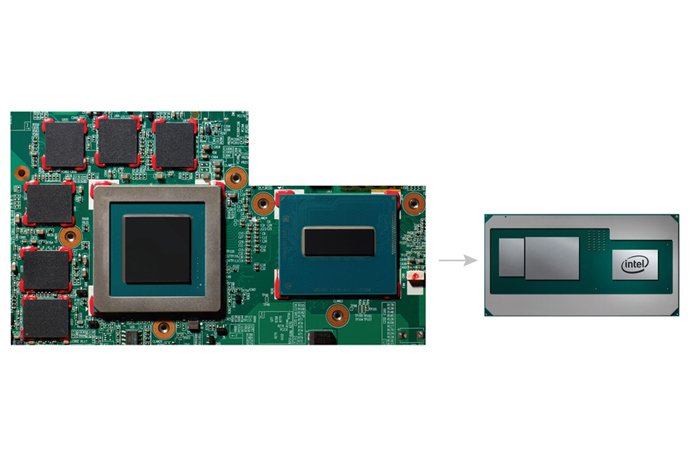Intel and AMD team up to integrate Radeon graphics with a Core CPU
Intel and AMD are joining hands to combine Radeon graphics and a Core CPU in a single package.

The rival chip manufacturers have announced a partnership that will see Intel produce a chip that combines an Intel CPU with an AMD graphics chip. The resulting chip will take advantage of a new process that should allow Intel and AMD to bring more robust graphics power to lightweight notebooks.
The goal, Intel explains, is to deliver the power that discrete graphics offer, but in a thinner package. To do this, Intel says it will rely on a new technology called Embedded Multi-Die Interconnect Bridge (EMIB), which it says can reduce the average silicon footprint to "less than half that of standard discrete components on a motherboard" by combining the CPU and discrete graphics into a single processor package. From Intel:
At the heart of this new design is EMIB, a small intelligent bridge that allows heterogeneous silicon to quickly pass information in extremely close proximity. EMIB eliminates height impact as well as manufacturing and design complexities, enabling faster, more powerful and more efficient products in smaller sizes. This is the first consumer product that takes advantage of EMIB.
In this case, Intel says it will opt for combining one of its eighth-generation Core H-series processors with a semi-custom graphics chip from AMD.
The partnership may seem like an odd one, but it makes sense from the standpoint of countering NVIDIA. AMD has already seen a resurgence in 2017, stoking competition with its chief graphics rival with new Radeon Vega graphics cards that can compete with NVIDIA at the high-end. And while it may not directly compete from a graphics standpoint, Intel is still facing potentially stiff competition from NVIDIA in the machine learning space.
Laptops using this new chip could give manufacturers a significant boost in power while dedicating more space to other components or slimming devices down. As for Intel and AMD, the chip gives the two firms a potential leg up over chunkier laptops that pack NVIDIA discrete graphics.
There's no word on an exact release date, but Intel says it expects manufacturers to begin shipping systems based on the new chip at some point in the first quarter of 2018. For now, have a glance at our overall roundup of the best graphics cards available now.
All the latest news, reviews, and guides for Windows and Xbox diehards.

Dan Thorp-Lancaster is the former Editor-in-Chief of Windows Central. He began working with Windows Central, Android Central, and iMore as a news writer in 2014 and is obsessed with tech of all sorts. You can follow Dan on Twitter @DthorpL and Instagram @heyitsdtl.

